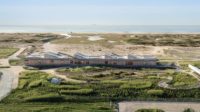Long Beach, California
The history of aviation in Long Beach, California, is legendary—from the landing, on its sandy shores, of the first transcontinental flight to its female-powered aircraft production during World War II and its more recent output of mammoth commercial and military jets. Yet, decades after vast and complex airports became the norm, Long Beach (LGB)'s passenger terminal remained a quaint relic of a bygone era.
As jet sizes and security requirements grew, LGB inserted a cluster of ad hoc passenger-handling structures—including more than 20 converted trailers—between the original building and its more ambitious airside. Despite the modesty of this municipal facility, it's always had impressive runways to accommodate the high-powered aeronautical manufacturers sharing the airfield. Along its edges, Boeing operates the former Douglas (later McDonnell-Douglas) plant, whose production has included DC-10s and C-17s, and Gulfstream Aerospace runs a finishing and servicing center.
In 2005, the airport explored updating the passenger facilities, engaging CH2M Hill engineers, with HOK, to produce an environmental-impact report (EIR). But community opposition—centered on Long Beach's stringent noise-abatement policies—stalled further work. There was also concern about preserving the prominence and integrity of this landmarked icon, as well as the ease and spirit of traveling through it.
By late 2010—agreeing on conditions such as capping the number of gates at the existing 11—the airport and community were finally ready to move forward. For the multiphased $140 million plan, HOK won the $45 million commission to design LGB's new concourses—providing gate-side boarding lounges and concessions—plus a security-screening building, a central meet-and-greet plaza, and adjacent grounds. (The historic terminal's renovation will occur in a later phase.)
Inspired by Southern California's mild climate, HOK's solution interweaves secure indoor and outdoor spaces, keeping the airport experience relaxed, even resortlike, while, almost imperceptibly, meeting the constraints of budget, access controls, and EIR-allowed square footage.
The modernization keeps the 1941 terminal front and center, the airport's gateway and pinnacle. The building houses many of its original functions: ticketing and check-in at grade; a restaurant overlooking the airfield one floor up; and a control tower, now used for backup operations, at the top. Still freestanding and requiring no security clearance for its public interior spaces, the building allows 360-degree circulation around its perimeter.
Beyond it, travelers pass HOK's open-air meet-and-greet plaza, en route to the 8,900-square-foot security-checkpoint building. Its steel moment frame allows for flexibility. “The TSA's setup changes all the time,” explains HOK design principal Ernest Cirangle, “so we needed to design for that.”
Once screened, passengers have the rare opportunity—within an airport—to enjoy the outdoors. To reach the concourses, they cross a secure 21,000-square-foot garden, studded with palm trees and native drought-tolerant plants. Its canopy-shaded wooden boardwalks evoke the city's beachfront. And the concessions are all local, including coffee and wine bars, plus a patio with fire pit–side dining.
Transparent and clean-edged, HOK's long, rectangular concourses house the boarding gates in two separate, aligned buildings (25,000 and 13,000 square feet, respectively). Between them is a garden, on axis with the original control tower.
The decision not to install any boarding bridges saved about $500,000 each (from a budget already significantly lower per gate than the average airport). It also let the architects keep the concourses low: one story, rather than the two required for jetways. So, the 1941 building remains visible throughout the facility.
“We weren't trying to mimic or upstage the historic terminal,” says Cirangle of HOK's design, now on track for LEED Gold certification. “Our idea was to quietly offer a different, but compatible experience that would complement or resonate with the original.” Retaining the sense of convenience, clarity, and proximity to the aircraft, the boarding lounges are at grade, with polished-concrete floors flowing directly out to the tarmac.
“It's more like a destination than a transportation hub,” says LBG senior civil engineer Jeff Sedlak. “I've seen arriving passengers lingering here for a glass of wine or a meal before exiting security.” And he often spots people snapping photos of the airport concourses—perhaps because the palm tree-and-boardwalk ambience has a way of making any arrival, whatever its purpose, feel like the beginning of a vacation.
PeopleOwner: City of Long Beach
Architect:
Personnel in architect's firm who should receive special credit: Interior designer: HOK (see project team above)
Engineers:
Civil:
Mechanical, Electrical, Plumbing, Fire Protection:
Information Technology:
Geotechnical:
Consultant(s):
Lighting:
Acoustical:
Baggage Handling:
Cost Estimating:
Signage & Graphics:
Code Consultant:
General contractor:
Photographer(s): David Lena, phone: 310-480-7007 Size: 46,000 square feet Construction cost: $28 million Project cost: $45 million Completion date: December 2012 |
Products
Structural system
Exterior cladding
Metal/glass curtain wall:
EIFS, ACM, or other:
Moisture barrier:
Curtain wall:
Roofing
Metal:
Glazing
Doors
Special doors:
Hardware
Closers:
Exit devices:
Security devices:
Interior finishes
Suspension grid:
Cabinetwork and custom woodwork:
Paints and stains:
Paneling: (metal wall panels, interior)
Plastic laminate:
Solid surfacing: Special surfacing:
Floor and wall tile:
Carpet:
Furnishings
Chairs:
Lighting
Downlights:
Exterior:
Dimming System or other lighting controls:
Plumbing
Energy
Photovoltaic system: |











